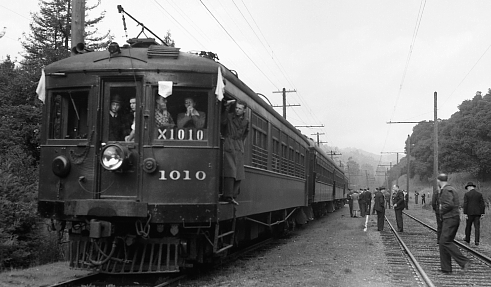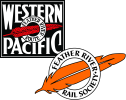THE BAY POINT & CLAYTON RAILROAD,
AN SN SHORTLINE CONNECTION
On April 2, 1939, an unusual excursion train ground to a halt at the obscure Sacramento Northern station dubbed "Clyde". The special was chartered by the Northern California Railroad Club, and was one of the earliest West Coast excursions sponsored by a railfan organization. The four-car train consisted of SN motor 1010, Hall Scott trailer 1021, Hall Scott motor 1020, and parlor car Moraga. Waiting at Clyde was Baldwin 0-6-0 #2 of the Bay Point & Clayton Railroad. The steamer coupled onto Moraga and pushed the train eight miles to the Cowell Portland Cement Company mill at the village of Cowell.
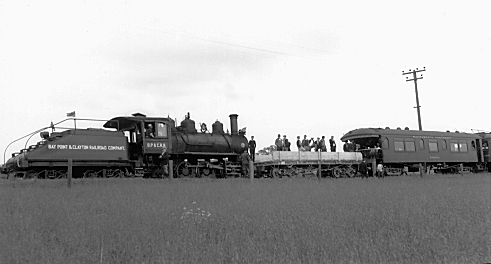
COWELL PORTLAND CEMENT COMPANY
Ernest Cowell and his family were already owners of the very successful Henry Cowell Lime and Cement Company in Santa Cruz, but became interested in developing limestone other deposits near Concord. In 1906 the Cowells incorporated the Cowell Portland Cement Company to work deposits at the foot of Mount Diablo. The operation was ideally sited to serve the booming San Francisco Bay Area market, especially following the great earthquake and fire. Cowell and his son Ernest, along with other family members who held nearly all the major positions in the firm, began building a cement plant near the quarry site in 1906. Opened in 1908, the plant included eight rotary kilns and could make 4,800 barrels of cement per day. Both waterproof and Portland cements were made, and were sold under the Mount Diablo brand name. The cement plant operated about six months each year, since the quarry couldn't be worked during wet weather.
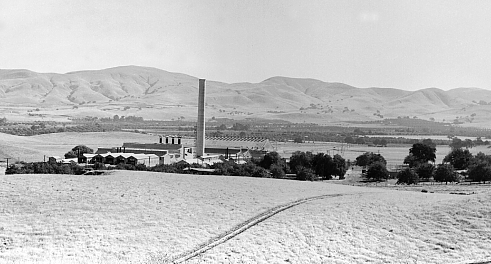
The cement plant was complimented by a typical company town, modestly christened "Cowell". It featured the usual general store, plus a hospital, firehouse and town hall. Fifty small houses were erected for the employees and their families, and two boarding houses were provided for unmarried workers. Employees were required to live in the town until the late 1930s. The Cowells were extremely paternalistic, and demanded strict loyalty from the employees, but in turn took very good care of their workers. The Cowells were also noted philanthropists, and gave generously to the University of California, as well as other worthy causes (think Henry Cowell Redwoods State Park at Felton).
THE BAY POINT & CLAYTON RAILROAD
Ernest Cowell tried to interest the Southern Pacific, and alternately the Santa Fe, in building a branch to the cement plant. Both lines refused. So on August 26, 1906, the Cowells incorporated their own shortline, the Bay Point & Clayton Railroad. Nobody pushed the Cowells around!
The line was originally planned to run twelve miles from Bay Point to the town of Clayton, with short branch to the cement plant at Cowell. Ernest Cowell saw the possibility of extra profits from the rich farms and orchards around Clayton. When word spread about the railroad, the cost of right-of-way through those same rich farms and orchards shot through the ceiling. The survey was quickly changed to run directly to Cowell, and Clayton was left to fend for itself without a railroad. Nobody pushed the Cowells around!
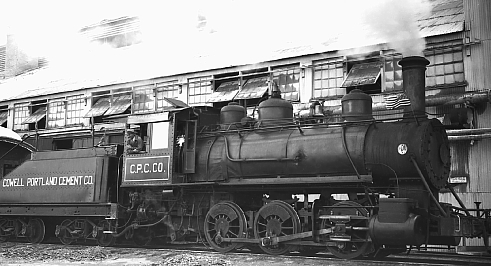
Two oil-burning Baldwin 0-6-0s were ordered in 1906. These were practically off-the-shelf machines, with 50-inch drivers, 18 X 24-inch cylinders, weighed 108,000 pounds, and provided 25,000 pounds of tractive force. No. 1 was lettered for the Bay Point & Clayton Railroad, and No. 2 carried the name of Cowell Portland Cement Company. By the time of the SN excursion, the two engines had switched places, maybe because the road engine had more wear than the mill switcher. There were no wye or turntables on the BP&C, so the locomotives always pointed towards Cowell. An open platform combine was obtained from the AT&SF. There were also two eight-wheel cars, a dump car and a flatcar. A four-wheel maintenance flatcar, probably rebuilt from a dump car, rounded out the roster. There was no caboose. When the 0-6-0s were in the shop (usually the SP's Bayshore facility), engines were rented from either the SP or the AT&SF. In August 1944, CPC Co. purchased State Belt Railway No. 6, another Baldwin 0-6-0. This engine was briefly used to serve the Naval Weapons Station Concord during construction, but that's getting way ahead of our story.
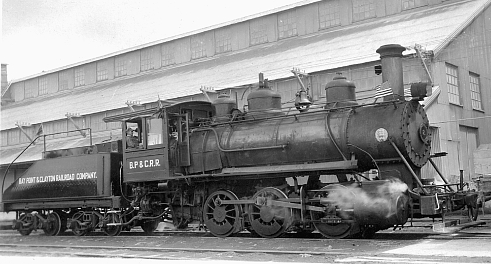
The little railroad was soon completed, but didn't become a common carrier until April 9, 1909. The first timetable was issued May 1. Train No. 1 ran Monday through Saturday. It left Cowell at 7:30 a.m., and arrived in Bay Point at 8:45. No. 2, the return train, left Bay Point at 10:45 a.m., arriving back at Cowell at noon. The distance covered was just 8.82 miles. In the mid-1930s, Train No. 1 left Cowell at 5 p.m., with a 5:30 arrival at Port Chicago. The return trip left at 6:05 p.m., and arrived back at Cowell at 6:40 p.m. This late train connected with SN's No. 8 at Clyde. All scheduled trains were mixed. The traffic was mainly outbound boxcars of bagged cement. Before trucks took the business, the line made a tidy bit of extra money carrying wine, grain, hay and other local agricultural products, some shipped by those same recalcitrant farmers.
AND NARROW GAUGE TOO!
To link Cowell with the quarry, the company added a three-mile narrow gauge line. For some unknown reason, the rare 42-inch gauge was selected over the more common 36 inches. The narrow gauge line connected the quarry to a crushing plant. From the crusher, the plant's internal standard gauge line was used to shuttle pulverized rock to the kilns.
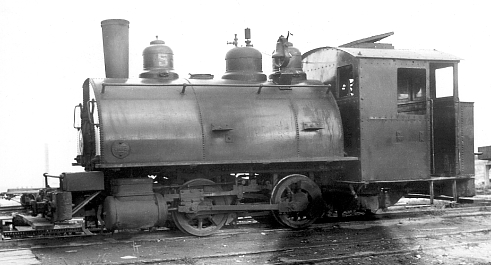
Two typical Baldwin 12-ton saddle-tank 0-4-0Ts, numbered 3 and 4, were purchased in 1907. An additional 13-ton machine was added in 1916, and a fourth 12-tonner came in 1924. Numbered 5 and 6 respectively, the latter two were also Baldwins. The line was originally equipped with wooden-framed Western side-dump cars. These were later replaced with 42 steel Kilbourn and Jacobs rocker bottom cars with a six-ton capacity. They were loaded by a Marion M37 electric shovel with a 1 3/4-yard bucket.
A FEW CHANGES, AND THAT HUGE SMOKE STACK
In 1910 the Oakland & Antioch successfully negotiated a crossing and interchange with the BP&C at Government Ranch (known as "Clyde" after 1918). The O&A track was laid in 1911. By 1913, the O&A had been folded into the Oakland, Antioch & Eastern. No doubt the Cowells were pleased to have a third outlet for their traffic. Although they now enjoyed good relations with the SP and AT&SF, the snub by the big lines refusing to run a branch to the plant wasn't forgotten. Remember, nobody pushed the Cowells around!
In 1918, the First World War cast its shadow over the BP&C. Pacific Coast Shipbuilding Company opened a government-sponsored yard on Suisun Bay a mile north of Bay Point. The BP&C was contracted to operate an extension to serve this plant, including a complicated trestle and fly-over across the SP and AT&SF mainlines. The OA&E operated a special train called "The Riveter" to Bay Point between February 1, 1919 and January 21, 1921. The electric trains did not actually run over the extension, which had no overhead wire. The shipyard workers had to walk from Bay Point to the shipyard, about 3/4 of a mile. After peace broke out, so to speak, there was little business for the shipyard. Closure ended both "The Riveter" and BP&C freight service over the extension.
As early as 1910, the owners of those rich farms and orchards around Cowell and Clayton complained about dust and ash from the cement plant damaging their crops. Their complaints fell on deaf ears. Nobody pushed the Cowells around! After over 20 years of griping, fourteen farmers finally brought a lawsuit against the Henry Cowell Lime and Cement Company to abate the nuisance in 1932.
When company official H. G. George was called to the stand, he was asked, "Are you the general manager and superintendent of the Henry Cowell Lime and Cement Company?"
"I am," he responded.
"And does not this company operate a cement manufacturing plant at Cowell in Contra Costa County?"
"It does not," came his firm reply.
After the judge restored order in the court, George patiently explained that the plant at Cowell was operated by the Cowell Portland Cement Company. Indeed, the two firms were controlled by the Cowell family, but they were entirely separate corporations. The farmers had sued the wrong company! The case had to be resubmitted at great expense to both sides.
The court eventually decided against the cement company in 1935. The Cowells were ordered install dust arrestors and to build a tall smoke stack. Legal arguments and counter-arguments dragged on until 1939, when the 235-foot stack was finally finished. Somebody had finally pushed the Cowells around, and actually gotten away with it! The stack was designed to cause the heavy particulate to fall the to bottom while the gasses rose to the top. The particulate was shoveled out from time to time, and given away as fertilizer.
BACK TO THE SN EXCURSION
Originally founded in 1935, the Northern California Railroad Club was one of the first railfan organizations in the country. Excursions had already been run over the East Bay Transit (Key System) and on the Market Street Railway in 1938. Their third excursion was the April 2, 1939 SN trip from San Francisco to Cowell.
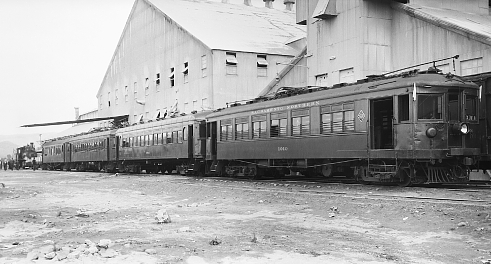
The train initially bypassed Clyde, and ran a bit further north to the West Pittsburg wye. Here the train was turned to put 1010 on the front for the return trip. Then the excursion returned to Clyde where BP&C. No. 2 coupled their one flatcar onto Moraga and pushed the train to Cowell. For the return trip, CPC Co. No. 1 tacked BP&C's combine onto 1010 and took the train back to Clyde. It is not well known today, but the excursion was followed by a short bob-tailed freight pulled by BP&C No. 2 (remember, the combine was on the passenger train). The excursion train stopped so the fans could get off and shoot a few pictures of the freight, though such photos are extremely rare today. Static close ups of the locomotives taken at the plant are more common, which we might chalk up both to the slow films of the time and Depression-era parsimoniousness by the railfans. The excursion was judged a great success, and set the pattern for many more Nor-Cal fan trips all over the west after World War II.
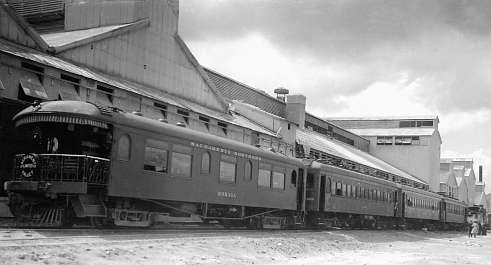
THE END FOR THE BP&C AND COWELL PORTLAND CEMENT CO.
War again cast its shadow over the BP&C in the 1940s. In preparation for the expected war in the Pacific, the Navy established the Naval Weapons Station Concord on government-owned land around Port Chicago. As the war heated up, the Navy bought (through condemnation) a huge tract of land between Port Chicago and Concord for ammunition bunkers. This included nearly 80 acres of the BP&C's right-of-way, plus the track, which was to form the stem of the Navy's own rail system. The sale price for the BP&C portion of the tract was $115,000. While abandonment proceedings worked their way through the Interstate Commerce Commission, the base commanding officer, Captain N. H. Gross, was listed in The Official Guide as "in charge" of the railroad. Despite Navy ownership, the BP&C legally remained a common carrier until July 24, 1946.
The Navy actually became the operator of the BP&C on July 1, 1945. Cars to and from Cowell were interchanged at Bollman Siding, at a cost to the cement company of $8 each. Although passenger service was still listed as available in The Official Guide until October, it probably also ended July 1st (and maybe as early as 1940, but that's not supported by continuing entries in The Official Guide). Cowell Portland Cement retained title to a short stub of the BP&C's old mainline beyond the Navy property, plus the plant track and the narrow gauge quarry line.
The end for the cement plant came in 1947. Through their union, the workers demanded a raise to $6 a day. The Cowells refused, and a picket lines promptly went up. The management simply refused to open the plant for the 1947 season. Nobody pushed the Cowells around! The decision was justified by claiming the quarry was worked out, which might actually have been close to the truth.
The standard gauge track was removed in 1951 and the three 0-6-0s were promptly scrapped. Narrow gauge engines 3, 4 and 6 were sold to South San Francisco Scrap Metals Company in 1952. There was some interest among some railfans in saving all three, but nothing happened until 1960. No. 3 was then sold to a railfan Charles Pollard and lovingly restored (sans saddle tank, and with a tender). Today this locomotive is owned by the City of Poway and operates on the Poway Midland Railroad in the city park.
Equipment from the plant was removed over a number of years. The kilns were sold to another cement company and taken out by truck in 1952. The empty mill buildings stood derelict into the late 1960s, when the land was sold for a subdivision. Everything but the fire house and the infamous chimney was torn down. That chimney became the centerpiece of a public park, and an ironic monument to the Cowell family, given that it represents one of the few times the Cowell family was pushed around. In March 2007 the Cowell Homeowners' Association voted to have the stack taken down. It had badly deteriorated, and restoration would cost $1.2 million, versus $735,000 for removal.
